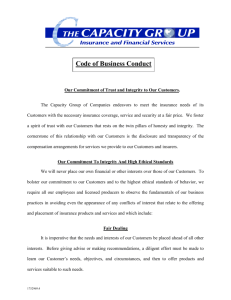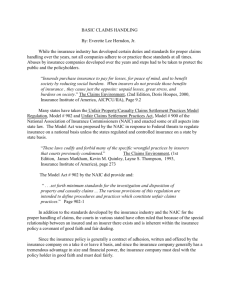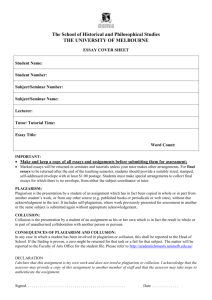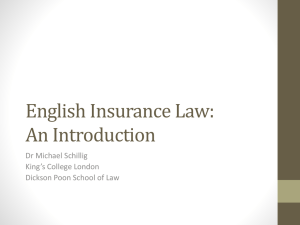Word - DutytoDefend.com
advertisement
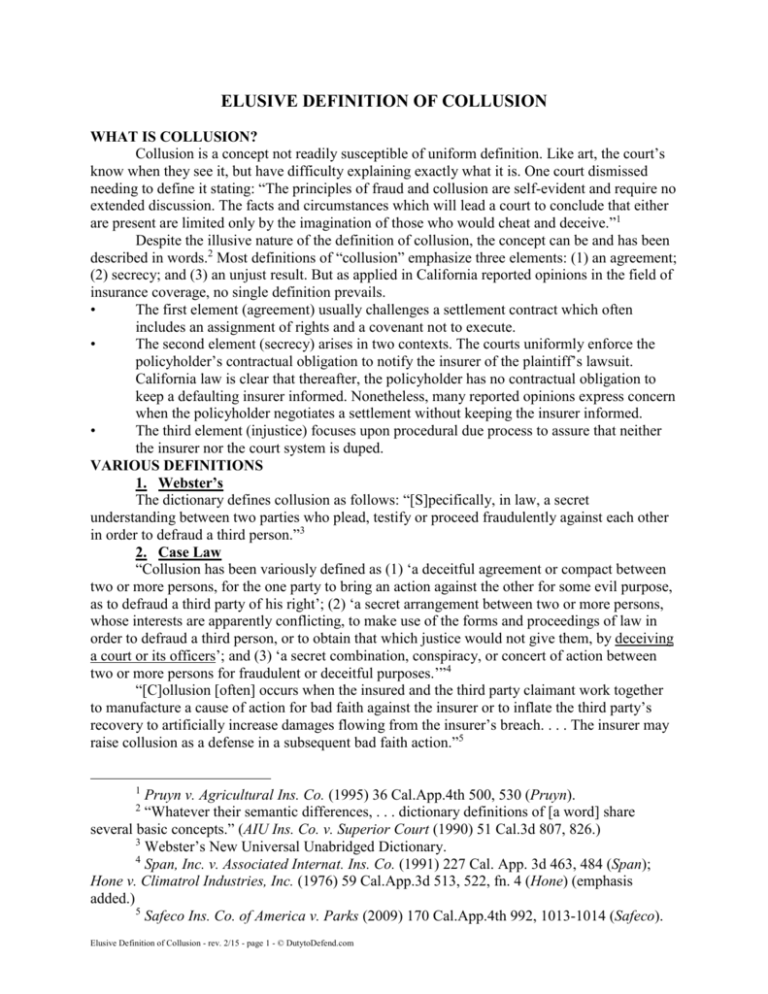
ELUSIVE DEFINITION OF COLLUSION WHAT IS COLLUSION? Collusion is a concept not readily susceptible of uniform definition. Like art, the court’s know when they see it, but have difficulty explaining exactly what it is. One court dismissed needing to define it stating: “The principles of fraud and collusion are self-evident and require no extended discussion. The facts and circumstances which will lead a court to conclude that either are present are limited only by the imagination of those who would cheat and deceive.”1 Despite the illusive nature of the definition of collusion, the concept can be and has been described in words.2 Most definitions of “collusion” emphasize three elements: (1) an agreement; (2) secrecy; and (3) an unjust result. But as applied in California reported opinions in the field of insurance coverage, no single definition prevails. • The first element (agreement) usually challenges a settlement contract which often includes an assignment of rights and a covenant not to execute. • The second element (secrecy) arises in two contexts. The courts uniformly enforce the policyholder’s contractual obligation to notify the insurer of the plaintiff’s lawsuit. California law is clear that thereafter, the policyholder has no contractual obligation to keep a defaulting insurer informed. Nonetheless, many reported opinions express concern when the policyholder negotiates a settlement without keeping the insurer informed. • The third element (injustice) focuses upon procedural due process to assure that neither the insurer nor the court system is duped. VARIOUS DEFINITIONS 1. Webster’s The dictionary defines collusion as follows: “[S]pecifically, in law, a secret understanding between two parties who plead, testify or proceed fraudulently against each other in order to defraud a third person.”3 2. Case Law “Collusion has been variously defined as (1) ‘a deceitful agreement or compact between two or more persons, for the one party to bring an action against the other for some evil purpose, as to defraud a third party of his right’; (2) ‘a secret arrangement between two or more persons, whose interests are apparently conflicting, to make use of the forms and proceedings of law in order to defraud a third person, or to obtain that which justice would not give them, by deceiving a court or its officers’; and (3) ‘a secret combination, conspiracy, or concert of action between two or more persons for fraudulent or deceitful purposes.’”4 “[C]ollusion [often] occurs when the insured and the third party claimant work together to manufacture a cause of action for bad faith against the insurer or to inflate the third party’s recovery to artificially increase damages flowing from the insurer’s breach. . . . The insurer may raise collusion as a defense in a subsequent bad faith action.”5 1 Pruyn v. Agricultural Ins. Co. (1995) 36 Cal.App.4th 500, 530 (Pruyn). “Whatever their semantic differences, . . . dictionary definitions of [a word] share several basic concepts.” (AIU Ins. Co. v. Superior Court (1990) 51 Cal.3d 807, 826.) 3 Webster’s New Universal Unabridged Dictionary. 4 Span, Inc. v. Associated Internat. Ins. Co. (1991) 227 Cal. App. 3d 463, 484 (Span); Hone v. Climatrol Industries, Inc. (1976) 59 Cal.App.3d 513, 522, fn. 4 (Hone) (emphasis added.) 5 Safeco Ins. Co. of America v. Parks (2009) 170 Cal.App.4th 992, 1013-1014 (Safeco). 2 Elusive Definition of Collusion - rev. 2/15 - page 1 - © DutytoDefend.com “[C]ollusion occurs when the insured and the third party claimant work together to manufacture a cause of action for bad faith against the insurer or to inflate the third party’s recovery to artificially increase damages flowing from the insurer’s breach.”6 “[A] cognizable claim of fraud or collusion would [require a showing that the third party claimant] had no substantial claim or chance of recovery and that the [insured] had permitted a judgment in [the claimant’s] favor which was disproportionate to his injuries; [and that the insurer] had no notice of this in time to intervene.”7 3. Collusion Is Distinct From Fraud Although collusion is often mentioned with fraud, the two claims are distinct.8 “Collusion . . . is not necessarily tantamount to the tort of fraud in that there need not be a misrepresentation of a material fact.”9 FACTORS TO CONSIDER Although the courts have not adopted a uniform definition of collusion, “[s]everal factors are relevant to a determination whether a settlement is collusive. These include, ‘the amount of the overall settlement in light of the value of the case; a comparison with awards or verdicts in similar cases involving similar injuries; the facts known to the settling insured at the time of the settlement; the presence of a covenant not to execute as part of the settlement; and the failure of the settling insured to consider viable available defenses.’”10 Reported opinions that discuss the collusion defense tend to use such words and phrases as “reasonable”, “unfair”, “good faith”, and “procedural due process” and “secrecy.” 1. Reasonable “[T]he insured is entitled to make a reasonable settlement of the claim in good faith and may then maintain an action against the insurer to recover the amount of the settlement.”11 “Provided that such settlement is not unreasonable . . . , the insurer will be bound thereby.”12 2. Fair “[A]ppellants will be entitled to litigate the issue of whether, as to them, the [settlement] Plan is unfair, unreasonable or the product of fraud or collusion.”13 Collusion seeks “to obtain that which justice would not give them, by deceiving a court or its officers.”14 3. Good Faith “The duty of good faith and fair dealing in an insurance policy ‘is a two-way street,’ running from the insured to his or her insurer as well as vice versa. Thus, in evaluating settlement of a claim where the insured and insurer may both incur liability, each assumes an obligation to act in good faith, to face the facts realistically, and to maintain a mutual respect for the interests of the other.”15 A settlement should reflect “an informed and good faith effort by the 6 Id. at 1013. Zander v. Texaco, Inc., supra, 259 Cal.App.2d at p. 806. 8 “The elements of fraud, which give rise to the tort action for deceit, are (a) misrepresentation (false representation, concealment, or nondisclosure); (b) knowledge of falsity (or ‘scienter’); (c) intent to defraud, i.e., to induce reliance; (d) justifiable reliance; and (e) resulting damage.” (Lazar v. Superior Court (1996) 12 Cal.4th 631, 638.) 9 Span, supra, 227 Cal. App. 3d at 484. 10 Safeco, supra, at 1013 (citations omitted.) 11 Isaacson v. California Ins. Guarantee Assn. (1988) 44 Cal.3d 775, 791. 12 Safeco, supra, at 1013. 13 Fuller-Austin Insulation Co. v. Highlands Ins. Co. (2006) 135 Cal.App.4th 958, 991. 14 Hone v. Climatrol Industries, Inc. (1976) 59 Cal.App.3d 513, 522, fn. 4. 15 Diamond Heights Homeowners Assn. v. National American Ins. Co. (1991) 227 7 Elusive Definition of Collusion - rev. 2/15 - page 2 - © DutytoDefend.com settling parties to reconcile their presumably differing views as to the relative strengths of their respective claims and defenses.”16 4. Procedural Due Process “If the [insurer] . . . is accorded due process in presenting its objections to the settlement . . . [it is] barred from making a claim of bad faith against the settling parties.”17 Placing the burden of proof of collusion on the insurer will give “meaningful protection to an insured who is abandoned by a liability insurer wrongfully denying coverage or refusing a defense and at the same time provide to the insurer some measure of procedural due process in order to protect against the consequences of a fraudulent or collusive settlement.”18 5. Notification and Secrecy Standard liability policies include a requirement that a policyholder notify the insure of a suit, but there is no contractual obligation to keep the insurer informed. “The ‘general rule’ is that an insurer is not bound by a judgment unless it had notice of the pendency of the action. However, if an insurer denies coverage to the insured, the insured’s contractual obligation to notify the insurer ceases. The insured is relieved of his obligation to inform the insurance company of the service of summons or the date of trial of the action.”19 Editorial Note: Nonetheless, to the extent that a policyholder and plaintiff keep the defaulting insurer informed of the particulars of a proposed settlement, the more likely it seems that a court’s concerns about standards of reasonableness, fairness, and good faith will be satisfied.20 Cal.App.3d 563, 578-579 (Diamond Heights) (citations omitted.) 16 Xebec Development Partners, Ltd. v. National Union Fire Ins. Co. (1993) 12 Cal. App.4th 501, 545. 17 Diamond Heights, supra, 227 Cal.App.3d at 582: see also, Pacific Estates, Inc. v. Superior Court (1993) 13 Cal.App.4th 1561, 1570. 18 Pruyn, supra, 36 Cal.App.4th at 530. 19 Samson v. Transamerica Ins. Co. (1981) 30 Cal.3d 220, 238 (citations omitted.) 20 See Article: Compendium of Collusion Cases. Elusive Definition of Collusion - rev. 2/15 - page 3 - © DutytoDefend.com


